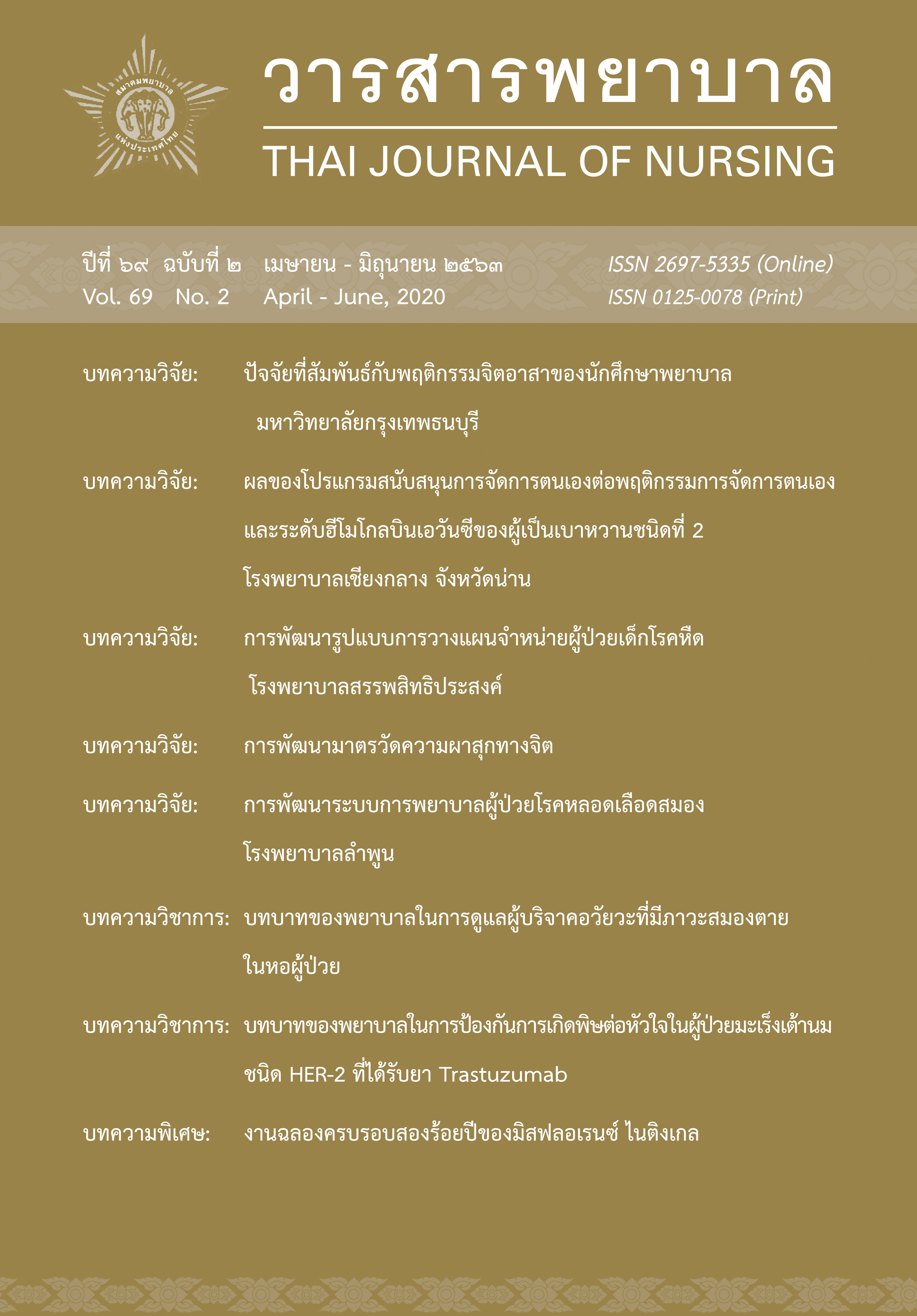The development of a Discharge Planning Model for pediatric patients with asthma at Sunpasitthiprasong Hospital
Main Article Content
Abstract
The purposes of this research and development were 1) to study problem situations and develop a discharge planning model for pediatric patients with asthma, and 2) to evaluate perception on self-efficacy and satisfaction toward the discharge planning model of caregivers after developing the model. The samples whom were purposively selected, were categorized in 3 phases. 1) Problem study phase included 3 groups: (1) eleven professional nurses who worked in pediatric ward 3 and attended brain storming, (2) five caregivers of asthmatic children who were interviewed, and (3) thirty-five caregivers of asthmatic children before trial. 2) The model development phase comprised eleven professional nurses who worked in this unit. 3) The trial phase, contained thirty-five caregivers of asthmatic children after trial. The research tools consisted of the questionnaires on caregivers’ perception on self-efficacy and satisfaction toward the discharge planning model. Their reliability coefficients were 0.95 and 0.85 respectively. In the trial stage, the discharge planning model was applied in a training project. Data were analyzed by descriptive statistics. The research findings were as follows. 1) Problems situations of discharge planning for pediatric patients with asthma revealed into 3 aspects including (1) structure: the hospital had the discharge planning policy without clear guidelines, performed discharge planning by own experiences, and no caregiver’s participation. (2) A process of discharge planning was performed unsystematically and the advice was mostly done on a discharge day. (3) Outcome revealed that there were no clear follow-up and evaluation. 2) The developed discharge planning model embraced systematic steps. This procedure began with discharge planning problems and needs assessing through caregivers’ collaboration, planning, implementing, and evaluating. These were integrated with the D-METHOD format and an empowerment concept along with discharge planning charts, nebulize equipment and the manuscript, and a teaching plan. 3) After the model development, caregivers’ perception on self-efficacy and satisfaction toward the discharge planning model were at the highest level.
Article Details
References
กันทิมา ขาวเหลือง. (2555). การพัฒนารูปแบบการวางแผนจำหน่ายทารกคลอดก่อนกำหนดที่ส่งเสริมการ
ดูแลต่อเนื่อง. วารสารวิจัยทางวิทยาศาสตร์สุขภาพ, 6(1), 27-39.
กัลยพัทธ์ นิยมวิทย์. (2560). การพยาบาลผู้ป่วยเด็กโรคหืดในการใช้ยาพ่นสูด: หลักการและแนวปฏิบัติ.
วารสารวิทยาลัยพยาบาลพระปกเกล้า จันทบุรี, 28(2), 192-201.
กัลยา เข็มเป้า. (2552). การพัฒนารูปแบบการวางแผนจำหน่ายผู้ป่วยโรคเบาหวานชนิดไม่พึ่งอินสุลินที่มี
แผลที่เท้า โรงพยาบาลพหลพลพยุหเสนา. วารสารกองการพยาบาล, 36(3), 113-132.
ชลธิชา ตั้งชีววัฒนกุล. (2561). ปัจจัยที่มีผลต่อการควบคุมอาการของผู้ป่วยเด็กโรคหืด โรงพยาบาลพังงา.
วารสารวิชาการแพทย์, 32(4), 1269-1281.
ฐิตินันท์ ไมตรี. (2558). ผลของการวางแผนจำหน่ายผู้ป่วยเด็กโรคหืดต่อความรู้และทักษะของผู้ดูแล.
สืบค้นเมื่อ 20 มกราคม 2561, จาก http://www.hospital.tu.ac.th/km/admin/new/200418_155909.pdf
บุญใจ ศรีสถิตย์นรากูร. (2553). ระเบียบวิธีการวิจัยทางพยาบาลศาสตร์ (พิมพ์ครั้งที่ 5). กรุงเทพ
มหานคร: ยูแอนไออินเตอร์มีเดีย.
ปริญญาพร ไหมแพง. (2559). ประสิทธิผลการดูแลรักษาของคลินิกโรคหืด อย่างง่ายในเด็กโรงพยาบาล
หล่มสัก. วารสารกรมการแพทย์, 41(3), 83-91.
สุนันท์ ขาวประพันธ์. (2555). ผลของการดูแลสุขภาพที่บ้านต่อพฤติกรรมของครอบครัวในการดูแลเด็ก
โรคหืด. วารสารสภาการพยาบาล, 27(2), 108-121.
Bandura, A. (1988). Self-efficacy: Toward a unifying theory of behavioral change. Psychological
Review, 84(2), 191-215.
Berry, J. G., Blaine, K., Rogers, J., McBride, S., Schor, E., Birmingham, J. . . Feudtner, C. (2014). A
framework of pediatric hospital discharge care informed by legislation, research, and practice.
The Journal of the American Medical Association Pediatrics, 168(10), 955-962.
Camp, P. G., Norton, S. P., Goldman, R. D., Shajari, S., Smith, M. A., Heathcote, S., & Carleton, B.
(2014). Emergency department visits for children with acute asthma: Discharge instructions,
parental plans, and follow-through of care-a prospective study. Canadian Journal of Emergency
Medicine, 16(6), 467-476.
Cherian, V. (2018). The global asthma report 2018. Retrieved March 1, 2019, from
http://www.globalasthmareport.org/Global%20Asthma%20Report%202018.pdf
Donabedian, A. (1992). The role of outcomes in quality assessment and assurance. Quality Review
Bulletin, 18, 356-360.
Gilad, C., Stan, G., & Dov, E. (2001). Validation of a new general self-efficacy scale, Retrieved
August 22, 2017, from https://www.researchgate.net/publication/228864305_Validation_
of_a_New General_Self-Efficacy_Scale
Kanter, R. M. (1979). Power failure in management circuits. Harvard Business Review, 57, 65-75.
Lampkin, S. J. (2016). Asthma review for pharmacists providing asthma education. Retrieved June 22,
, from https://www.ncbi.nlm.nih.gov/pubmed/27877099
McKeehan, K. M., & Coulton, C. J. (1985). A system approach to program development for continuity
of care in hospitals. In K. McClelland, K. Kelly, & K. Buckwalter (Eds.). Continuity of care:
Advancing the concept of discharge planning (pp. 79-92). Orlando, FL: Grune & Stratton.
Wong, E. L., Yam, C. H., Cheung, A. W., Leung, M. C., Chan, F. W., Wong, F. Y ., & Yeoh, E. K.
(2011). Barriers to effective discharge planning: A qualitative study investigating the perspectives
of frontline healthcare professionals. BioMed Central Health Services Research, 11(1), 242.


